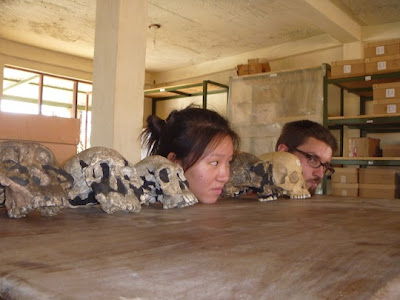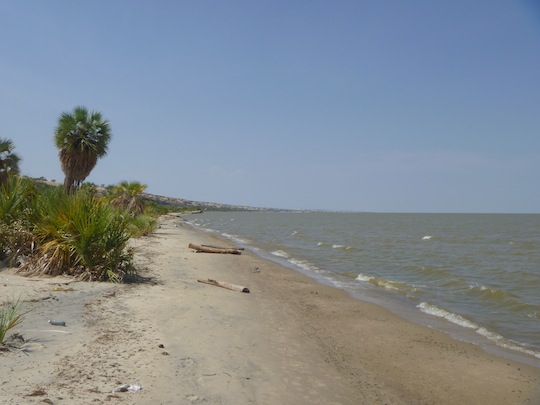Hey everybody!
This week I would like to change up the format and incorporate a short biography of our last professor, Bernard Wood. But first, I'd like to show you the evolution of anthropology-related humor:
 |
| Bernard Wood |
Bernard Wood was born in Stoke Newington, London. His parents were grocers, and he delivered groceries on bike for them as a kid. While most of the people living in the affluent neighborhoods wouldn't acknowledge him, Bernard remembers a cardiologist who would always thank him and invite him inside for tea. It was then that Bernard decided that he wanted to become a doctor.
When he was young, Bernard had a bad stammer, which he compared to King George VI in "The King's Speech". As a result, language classes made him uneasy, and he gravitated towards the harder sciences throughout his schooling. In 1964, after taking a year off to teach history and science in North Wales, Bernard enrolled in Middlesex Hospital School in London. He excelled in anatomy and graduated in 1966 after completing a research project on a Homo habilis talus (a foot bone).
Bernard also developed his passion for human evolution during college. He remembers making note cards for every single hominin fossil ever found and studying them until he knew the details of every one. Through a connection with Michael Day, an anatomist who knew Mary Leakey, he was invited to join the research project at Koobi Fora on the western side of Lake Turkana (then Lake Rudolf) and shipped off in 1968. After using up his 48 of the 50 pounds of his grant on airfare, and traveling on an old troop plane with canvas seats, he managed to get to Koobi Fora and met Richard Leakey. This part of Lake Turkana was largely unexplored at this time, and there weren't any landing strips for planes, so they had to do the best they could with flat land. The only roads in the area were made during the second World War by the British who were fighting against the Italians, and not particularly useful. The area was also home to many more animals than nowadays, and he remembers seeing zebra, giraffe, lions, cheetahs, and antelope. After spending two months in Kenya, Bernard returned to England and completed his degree in medicine and surgery in 1970 from the University of London.
Bernard also developed his passion for human evolution during college. He remembers making note cards for every single hominin fossil ever found and studying them until he knew the details of every one. Through a connection with Michael Day, an anatomist who knew Mary Leakey, he was invited to join the research project at Koobi Fora on the western side of Lake Turkana (then Lake Rudolf) and shipped off in 1968. After using up his 48 of the 50 pounds of his grant on airfare, and traveling on an old troop plane with canvas seats, he managed to get to Koobi Fora and met Richard Leakey. This part of Lake Turkana was largely unexplored at this time, and there weren't any landing strips for planes, so they had to do the best they could with flat land. The only roads in the area were made during the second World War by the British who were fighting against the Italians, and not particularly useful. The area was also home to many more animals than nowadays, and he remembers seeing zebra, giraffe, lions, cheetahs, and antelope. After spending two months in Kenya, Bernard returned to England and completed his degree in medicine and surgery in 1970 from the University of London.
 |
| A picture of the amazing rain clouds that we've been having |
In 1972, Richard invited Bernard back to Koobi Fora to be one of three anatomists studying the hominid fossils on the site. He and the other two, Michael Day and Alan Walker, drew matches to see which one of them had to study the skull fragments. Bernard lost, and got to work trying to figure out how many different species the cranial fossils at Koobi Fora represented. A major problem in paleoanthropology is trying to distinguish the variation within a species from the variation between different species, a problem that Bernard has been tackling ever since. Meanwhile, he was appointed Lecturer of Anatomy at Middlesex Hospital Medical School, and was also a practicing doctor for a couple of years.
In 1975, Bernard completed his PhD from the University of London for his work on the fossils at Koobi Fora. He continued teaching at the Middlesex Hospital Medical School until 1985, when he moved to Liverpool. In 1991 he published the monograph for all of the fossils found at Koobi Fora, a task that took him 16 years to complete. In it, he identified the main distinguishing traits between Homo habilis and Homo rudolfensis. Since then, Bernard has done extensive research on which skeletal traits can be reliably used to distinguish between different species and which can't
 |
He currently works at George Washington University as the University Professor of Human Origins. He notes that he is probably one of the last people to get a medical education and go into paleoanthropology. Many historical scientists, including Charles Darwin and Thomas Henry Huxley, went to medical school before becoming luminaries in the field of human evolution. Bernard thinks that studying medicine has made him more comfortable than other researchers with the vagueness inherent in the fossil record. One is never completely sure of anything in medicine (as much as we don't want to hear it), and the same is certainly true of the fossil record.
 |
| A very well preserved fish bone |
Back to us students, the highlight of our week was a visit to Eliye Springs, a beach next to some rock exposures that are home to some very well preserved fossils. After searching the hills and the shoreline and finding mostly fish bones, we decided to take a swim. But we were warned not to swim too far out, because Lake Turkana is home to some hungry crocodiles.
 | |
| Wesly Morton "eating" a large beetle we found on the edge of the river |
Tomorrow we begin Archaeology, our final module. The time sure has flown!
 |
Until next week!




No comments:
Post a Comment